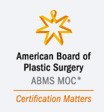

Life takes a toll on a person’s abdominal area. Age, childbearing, and changes in weight can trigger sagging muscles, extraneous skin and deposits of fat, and the result is a stomach that is flabby rather than toned. Fortunately, a tummy tuck can offer a viable solution for those who want a flat, youthful stomach.
Also known as abdominoplasty, a tummy tuck tightens the abdominal muscles and removes extra skin and fat from the stomach area, creating a narrower waist and a flatter belly. It is an option more and more people are turning to. According to the American Society of Plastic Surgeons, roughly 60,000 of these surgeries were performed in 2000. In 2014, the number of tummy tucks performed had nearly doubled to almost 120,000.
The Consultation
Tummy tucks are highly individualized procedures that are carefully designed to create the best possible result. They can offer long-lasting results, so it is vital that patients are confident in their choices. This makes a tummy tuck consultation with an experienced plastic surgeon invaluable.
During the consultation, you will be asked about your overall health, including your health habits, any medical issues that you have and any medications that you take. You will also discuss what you hope to achieve and undergo a physical examination. Once your plastic surgeon understands your goals and has had a chance to study your anatomy, he will talk about what is possible, explaining possible outcomes as well as possible limitations to a great result. Factors like skin quality, previous surgeries, the location of fat deposits and general anatomy will likely be discussed so that you understand how they might affect your results. Finally, the plan for your surgery will be described in detail. You will learn about pre-op requirements, the steps involved in the actual surgery and what to expect during your recovery.
Types of Tummy Tucks
There are many types of tummy tucks. Which one is right for you? It depends on your goals and your existing anatomy. A few options include:
- Mini tummy tucks are intended for people who have a small bulge in the lower abdomen. They treat the area between the belly button and the mons pubis.
- Full tummy tucks are suitable for people whose issues extend both above and below the belly button.
- Extended tummy tucks are basically full tummy tucks on a slightly larger scale. In these procedures, the incisions are extended to allow a wider area to be treated.
- Fleur de lis tummy tucks are ideal for individuals whose significant weight loss has left them with a substantial amount of loose skin above their belly button.
Possible Incisions
With the potential for scarring, it is understandable that many tummy tuck patients are curious about the placement of incisions. Incision placement and length is variable from patient to patient, as is the potential for a vertical scar, and this is discussed at your consultation. In general, for mini and full tummy tucks a horizontal incision is made between the hipbones; in many cases, this is low enough that any scar would be hidden by underwear or bikini bottoms. With extended tummy tucks, the incision is longer to allow the surgeon to remove more tissue. Only a fleur de lis tummy tuck requires a different type of incision. In this procedure, a long vertical incision accompanies the traditional horizontal incision. The resulting pattern of incisions resembles an anchor or lily.
Tummy Tucks and Liposuction
To create the flat belly that patients desire, abdominoplasty is often combined with liposuction. However, the extent of the liposuction varies. Dr. Shahram Salemy, a board certified plastic surgeon who offers customized tummy tucks to patients in the Seattle-area practice, will incorporate liposuction of the hips and love handles with a tummy tuck. However, he generally prefers to avoid liposuctioning the stomach area itself because he does not want to interfere with blood flow or slow the healing process.
The Surgery
While each tummy tuck is a unique operation, they all follow a similar format. These procedures generally require two to three hours and involve certain basic steps, including:
- Administering anesthesia.
- Making the incision.
- Lifting the skin to allow the surgeon to access the underlying tissues.
- Repairing the muscles by stitching together sagging or weak muscles, creating a firmer stomach and narrower waist.
- Redraping the skin by pulling the skin down and excising any extra skin.
- Inset of the belly button.
- Closing the incision with a multiple layers of sutures. Drain tubes are used temporarily to permit drainage from the surgical site before the area is covered with surgical dressings.
After the surgery, patients will be provided with instructions for their post-surgery care. The typical recovery period is two weeks, and most patients can resume their exercise regimen after six weeks.
Is Abdominoplasty Right for You?
Abdominoplasty is a major surgery, so potential patients should discuss any medical issues with their surgeon. Good candidates for this procedure are generally healthy individuals who are unhappy with the appearance of their stomach area and have reasonable goals for improvement. Ideally, they should be nonsmokers; smokers must commit to put their habit on hold for a period extending from 4-6 weeks prior to the surgery to at least six weeks after it. It is also important that candidates maintain a stable weight. Anyone who plans to lose additional weight should do so before undergoing a tummy tuck because weight loss often results in loose skin. Women who intend to become pregnant may prefer to wait until after they are done with childbearing to have the procedure.
The Anatomy Effect
While it is not widely discussed, anatomy is another factor that must be considered when determining what results can be attained with an abdominoplasty. What anatomical issues typically influence the results? Scarring from past abdominal surgeries can be problematic because it complicates any future surgery. The location of fat deposits also matters. While a tummy tuck can address fat located in front of the muscle effectively, it cannot alter visceral fat, the fat that is behind the muscle wall. Skin quality and body type also play roles in what results are achievable.
Tummy tucks and human bodies are both highly individualized; with so many varied possibilities, it can be difficult to talk about their intersections in a way that is both concise and sensible. Ultimately, a consultation with an experienced plastic surgeon is the best way to discover how your anatomy will impact a tummy tuck. For those who are trying to get a basic idea of what is possible, Dr. Salemy’s website has a tummy tuck photo gallery that features images of women of various sizes and body types; this helpful resource makes it easier for women to visualize what their own results might be.
While time and aging will cause some changes, the results are generally long-lasting, in particular for patients who maintain a healthy lifestyle, and secondary tummy tucks are uncommon.
Related Topics:















